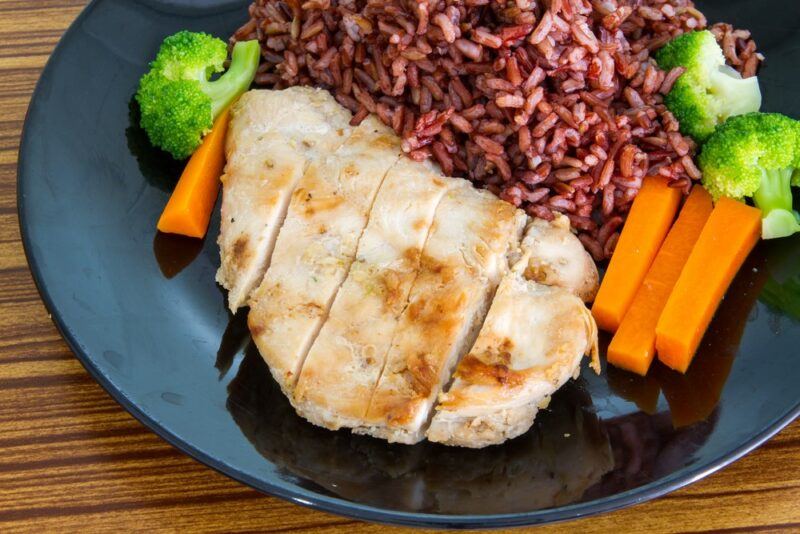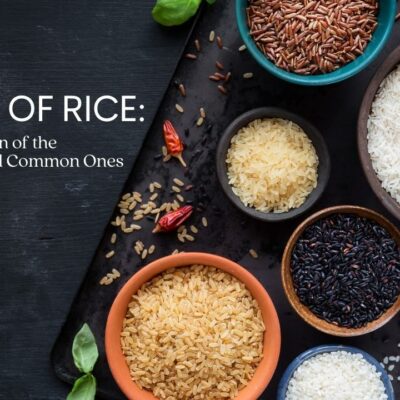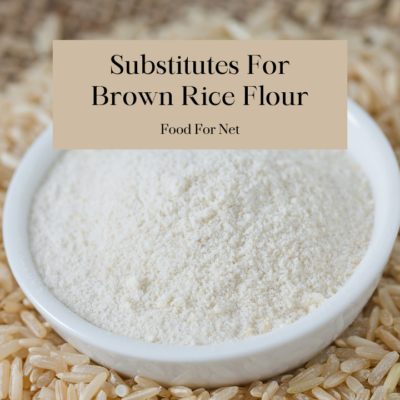
Rice is a simple ingredient, which should make it easy to talk about. Yet, when it comes to nutrition, things get surprisingly complicated. Despite how popular rice is throughout the world, we’re often told that it lacks nutrients and isn’t that beneficial. Brown rice seems to be a better choice than white rice, with extra nutrients and more fiber (you can even find brown rice protein powder), but is brown rice good for you?
The answer, it seems, varies depending on who you ask. Paleo dieters, for example, see no end of problems with brown rice, partly due to compounds found in the outer layer. Other health advocates suggest that brown rice is incredibly healthy, as it’s a whole grain that provides plenty of fiber.
And, as contradictory as these arguments are, they both have some good points. So, with this post, let’s take a close look at the strengths and weaknesses of brown rice. We’ll also talk about how it compares to white rice, including whether brown rice truly is the better choice.
Is Brown Rice Good For You?
- Benefits Of Brown Rice
- The Problems With Brown Rice
- Brown Rice Versus White Rice
- How Do You Use Brown Rice Well?
- Healthy Alternatives To Brown Rice
- Final Thoughts
Benefits Of Brown Rice

Versatile
Rice is popular because it can be used in so many ways. Many dishes, like curries and stews, are excellent with rice as a side dish. Then there are all the meals that use rice as an ingredient, including rice-heavy dishes like fried rice.
Don’t forget that rice is also inexpensive, easy to find, and stores well. Those features all make it perfect in many situations, even if you don’t have much money to spare.
White rice tends to be the more versatile choice, as it is soft and has barely any flavor of its own. Still, brown rice can be used in most of the same recipes. The extra flavor and texture that brown rice brings can even be a good thing – helping to make your meals much more interesting.
The Fiber Content
Because brown rice still has the bran and the germ layer, it contains a decent amount of fiber. This fiber plays many roles in your body, helping to keep you regular, improving digestion, and even promoting weight loss.
While there are plenty of other sources of fiber too, brown rice is a powerful one. After all, you can include it in many different meals. You get even more benefits if you include other fiber rich foods in the same meal.
The fiber also gives brown rice a different glycemic index than white rice, meaning that the rice is digested more slowly and doesn’t spike your blood sugar in the same way. That effect is perfect for many situations. You can even eat brown rice if you have diabetes, while white rice is a bad idea in that situation.
It’s A Whole Grain
Rice is also considered a whole grain, which simply means that all parts of the grain are present. Despite the controversy surrounding carbs and grains, there’s plenty of evidence that a diet rich in whole grains promotes health in countless ways.
For example, whole grains decrease the risk of heart disease, diabetes, and high blood pressure. And that’s just a few of the benefits.
Whole grains also feature heavily in many healthy diet approaches, including the Mediterranean diet. That’s evidence enough for their benefits.
Besides, most of the problems with carbs come from diets that are rich in refined and simple carbs. The worst issues come when you’re relying on processed foods, as these are often limited in nutrients and contain far too many additives.
The Nutrients

Brown rice isn’t exactly packed with nutrients, but it does contain more nutrients than white rice. This is because most of the nutrients are in the germ and the bran, both of which get removed when making brown rice.
Selenium and manganese are some of the most significant nutrients. You also get a decent amount of thiamin (vitamin B1), niacin (vitamin B3), copper, magnesium, and phosphorous. That’s not too bad when you think about how many meals can include brown rice.
Might Promote Weight Loss
Brown rice isn’t well-known as a weight loss food, but the fiber it contains can help to keep you full, which does promote weight loss. That effect may be even stronger if you’re replacing refined grains with brown rice instead.
Even the simple switch from white rice to brown rice could be enough to help you lose weight. After all, white rice is little more than simple carbs, while brown rice has fiber, so it should make you feel full faster.
May Promote Heart Health
The fiber in brown rice has many potential benefits, including the chance to help with your heart health. One study found that diets high in fiber had decreased risk of death from cardiovascular causes, along with respiratory diseases and infectious diseases.
The trick for doing so is to regularly choose fiber rich foods rather than low fiber alternatives. Eating brown rice rather than white rice, for example, could have a significant impact, particularly if you eat rice often.
Brown rice may have other heart health impacts too, due to the presence of lignans. These plant-based compounds may decrease blood pressure, arterial inflammation, and fat in your blood.
Let’s not forget that whole grains, in general, are often linked to decreased heart disease risk as well.
Rice Is Gluten Free
While rice is a grain, it is still naturally gluten free. This makes it ideal for anyone following a gluten free diet – or if you just want to lower your gluten intake.
Plus, brown rice is a whole food. It’s much less processed than many other gluten free options and contains more nutrients too.
You’ll also find brown rice used as an ingredient in some gluten free products. However, this is an area to be careful with, as heavily processed products simply don’t have the same benefits as whole foods.
The Problems With Brown Rice

Brown rice is often touted as being amazing. We’ve already talked about the benefits, but there’s a dark side to brown rice too.
The Antinutrients
The outer shell of brown rice contains some antinutrients, including phytic acid. While antinutrients are naturally occurring compounds, they’re also controversial, as they may impact our digestion of nutrients.
This could mean that eating brown rice decreases the nutrients that you get from the vegetables and other ingredients in your meal.
How serious is this problem? Well, we don’t really know.
Most research shows plenty of benefits from brown rice and other whole grains, and few risks. However, the nature of the research would make spotting any problems difficult. Brown rice could, in theory, have many obvious positive effects and some hard-to-spot negative ones.
Risk Of Arsenic Poisoning
Arsenic is a heavy metal, one that’s toxic. It’s a growing concern, as arsenic levels in some foods are beginning to increase, due to environmental pollution. Inorganic arsenic is the most dangerous type and rice is the single largest source of this arsenic. Pretty scary, right?
Washing your rice first can help with the arsenic levels, as long as you’re using arsenic-free water.
Unfortunately, brown rice is the worst choice for arsenic, as the heavy metal accumulates in the bran layer. This means that if you’re eating rice often, like a serving or more most days, you might be putting yourself at risk. Switching to white rice and rinsing the rice before cooking it can help, but even then, you might want to cut down your rice consumption.
Arsenic levels do vary. The type of rice, where it was grown, the season, and the environment can all influence arsenic levels. However, the only way to be confident would be to test each type of rice, so as a consumer, you simply have no way of knowing.
Carb Content
Brown rice is a whole grain, one that contains complex carbs and is thought to be good for you. Yet, it’s still a high carb food. You get roughly 44 grams of carbs in a cup of cooked brown rice (which isn’t an unusual serving size).
There is fiber present, but, on average, less than 4 grams of those carbs come from fiber. This gives you a lot of digestible carbs in each serving of brown rice.
So, is the rice worth it?
That depends on how you feel about carbs. There’s plenty of debate in this area. Many people still feel that carbs aren’t a big deal and that if there is a problem, it’s fat and calories. Others argue that high carb diets are the reason that our population is increasingly overweight and sick.
If you’re trying to keep your carb intake as low as possible, then brown rice is a bad choice.
Many People Don’t Like It
Brown rice doesn’t have a strong flavor, but the taste is more distinctive than regular white rice. It’s also a bit chewier and doesn’t work as well in some dishes.
While the differences aren’t dramatic, many people prefer white rice. Some will even struggle to eat brown rice.
This is a problem because, honestly, the differences between brown and white rice aren’t as significant as you might expect. We’ll discuss these in the next section, but, in general, the ingredients you’re having with the rice matter more than which type of rice you choose.
Brown Rice Vs White Rice

The difference between brown rice and white rice comes down to processing. With white rice, the bran and the germ are removed, leaving you the endosperm, which is high in carbs.
Brown rice still has the germ and bran, making it much more nutritious. You don’t just get more fiber either. Brown rice also contains higher levels of many vitamins, minerals, and antioxidants.
Yet, as we’ve already mentioned, brown rice has issues too. The antinutrients could be a problem
How Do You Use Brown Rice Well?
Some uses of brown rice are obvious. You can create a simple side dish by cooking the rice and perhaps including a couple of spices for some extra flavor.
Or, you could create a rice risotto or something similar. Most white rice recipes work just as well with brown rice, so feel free to experiment and see what works for you.
Those options are just scratching the surface. There are plenty of other ways to use brown rice too. For example, rice can be used as an ingredient to make vegan burger patties or energy bars. You can use brown rice as the base of a power bowl too, topping it with ingredients like eggs, avocados, and tomatoes.
You can even use brown rice in recipes that traditionally rely on white rice, like sushi or rice pudding. Relying on brown rice does change the texture and flavor profile of the dishes. Still, such changes aren’t always bad and using brown rice gives you more nutrients and fiber (which is always a good thing).
Healthy Alternatives To Brown Rice
If you’re worried about the antinutrients, arsenic, or carbs in brown rice, the simplest option is to swap brown rice out for a different ingredient.
The first alternative is to use a different grain or pseudograin. Quinoa is popular here, as the pseudograin can be used in the same way as rice, but it’s much more nutrient dense.
Of course, most grains and pseudograins are high in carbs. Many have some of the antinutrients that are present in brown rice too, so they might not be what you’re looking for.
Cauliflower rice is another option. This is simply raw cauliflower that has been processed into small pieces, roughly the size of rice grains. You can use cauliflower rice in many of the same meals as regular rice, but it’s worth finding a recipe first, as you’ll need to prepare this differently than regular rice.
Other vegetables are sometimes used to replace rice too, like cabbage, riced broccoli, or zucchini. These all provide different nutrients than you get with rice and are generally low in calories. Most will also be low carb, but you’ll need to check on a case-by-case basis.
Finally, you can look for manufactured low carb rice products, like rice made from shirataki noodles. Shirataki rice is made from konjac root and has a nasty smell straight out of the bag. Some of this smell goes away once you rinse the rice and plenty of people swear by shirataki rice and noodles, so they can’t be as bad as they first seem.
You might need to experiment to find out which type of rice works for you. After all, they all have very different flavors and textures, and behave differently when you cook them.
Final Thoughts

Brown rice does have many good features. It’s inexpensive, is easy to cook, and offers a decent amount of fiber. Yet, as you’ve seen, there are multiple problems as well, including the carbs, the antinutrients, and the risk of arsenic contamination.
Despite the potential issues, brown rice isn’t something to avoid entirely.
Most foods have their good points and their bad points. But, eating well doesn’t involve choosing the best possible foods every single time. Instead, you’ll go far by focusing on whole foods, particularly those that are nutrient-dense.
While rice isn’t a nutrient-dense food, it’s pairs well with countless vegetables, sauces, and sources of protein. This effect alone makes it a good choice. Because, when you get down to it, any food that promotes healthy eating is good for you and rice certainly achieves that goal.
Frequently Asked Questions
Is Brown Rice Gluten Free?
All types of rice are naturally gluten free, including brown rice. This means that most people with gluten intolerance can eat rice regularly.
Interestingly, rice does contain a type of gluten, although this doesn’t cause the same reactions as the gluten found in bread. This protein isn’t likely to be an issue unless you consume excessive amounts of rice.
Is Brown Rice Good For Diabetics?
Brown rice has a lower glycemic than white rice, which can make it helpful for people with diabetes. The fiber content is also helpful for promoting long-term health and reducing the risk of diabetic complications.
However, brown rice can still spike blood sugar, so it’s important to keep an eye on your portions. Serving the rice with plenty of vegetables and lean protein will give you the best possible outcomes.
Is Brown Rice Keto Friendly?
Brown rice is a grain and is fairly high in carbs, factors that make it a poor choice for keto dieters. In fact, even just half a cup of the cooked rice gives you more than 20 net grams of carbs.
Many keto dieters focus on low carb alternatives, like cauliflower rice. While cauliflower rice doesn’t have exactly the same flavor or texture, it is much lower in carbs and a better fit for keto.
Does Brown Rice Take Longer To Cook?
Yes. Brown rice takes roughly twice as long to cook as white rice and sometimes even longer than that – even though the grains are cooked in roughly the same way.
Is Brown Rice Inflammatory?
Brown rice is often seen as inflammatory, largely because it is high in carbs. However, brown rice is also an unrefined whole grain that contains plenty of fiber. Those features mean that brown rice could easily decrease inflammation, rather than causing it.
In fact, swapping from white rice to brown rice could be a simple way to lower inflammation and improve your health.









 16 Spices for A Heartwarming Beef Stew Plus Cooking Tips and Easy Recipes for You to Try
16 Spices for A Heartwarming Beef Stew Plus Cooking Tips and Easy Recipes for You to Try
The article is well put together. It states the facts and suggests other alternatives. Thanks.